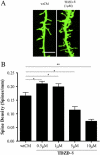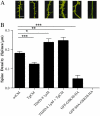Activation of glycogen synthase kinase-3 beta mediates β-amyloid induced neuritic damage in Alzheimer's disease
- PMID: 21945540
- PMCID: PMC3694284
- DOI: 10.1016/j.nbd.2011.09.002
Activation of glycogen synthase kinase-3 beta mediates β-amyloid induced neuritic damage in Alzheimer's disease
Abstract
β-Amyloid (Aβ) plaques in Alzheimer (AD) brains are surrounded by severe dendritic and axonal changes, including local spine loss, axonal swellings and distorted neurite trajectories. Whether and how plaques induce these neuropil abnormalities remains unknown. We tested the hypothesis that oligomeric assemblies of Aβ, seen in the periphery of plaques, mediate the neurodegenerative phenotype of AD by triggering activation of the enzyme GSK-3β, which in turn appears to inhibit a transcriptional program mediated by CREB. We detect increased activity of GSK-3β after exposure to oligomeric Aβ in neurons in culture, in the brain of double transgenic APP/tau mice and in AD brains. Activation of GSK-3β, even in the absence of Aβ, is sufficient to produce a phenocopy of Aβ-induced dendritic spine loss in neurons in culture, while pharmacological inhibition of GSK-3β prevents spine loss and increases expression of CREB-target genes like BDNF. Of note, in transgenic mice GSK-3β inhibition ameliorated plaque-related neuritic changes and increased CREB-mediated gene expression. Moreover, GSK-3β inhibition robustly decreased the oligomeric Aβ load in the mouse brain. All these findings support the idea that GSK3β is aberrantly activated by the presence of Aβ, and contributes, at least in part, to the neuronal anatomical derangement associated with Aβ plaques in AD brains and to Aβ pathology itself.
Copyright © 2011 Elsevier Inc. All rights reserved.
Figures











References
-
- Akiyama H, et al. Pin1 promotes production of Alzheimer's amyloid beta from beta-cleaved amyloid precursor protein. Biochem. Biophys. Res. Commun. 2005;336:521–529. - PubMed
-
- Aplin AE, et al. Effect of increased glycogen synthase kinase-3 activity upon the maturation of the amyloid precursor protein in transfected cells. Neuroreport. 1997;8:639–643. - PubMed
-
- Bao Y, et al. Activation of peroxisome proliferator-activated receptor gamma inhibits endothelin-1-induced cardiac hypertrophy via the calcineurin/NFAT signaling pathway. Mol. Cell. Biochem. 2008;317:189–196. - PubMed
-
- Barco A, et al. Expression of constitutively active CREB protein facilitates the late phase of long-term potentiation by enhancing synaptic capture. Cell. 2002;108:689–703. - PubMed
Publication types
MeSH terms
Substances
Grants and funding
LinkOut - more resources
Full Text Sources
Other Literature Sources
Medical

